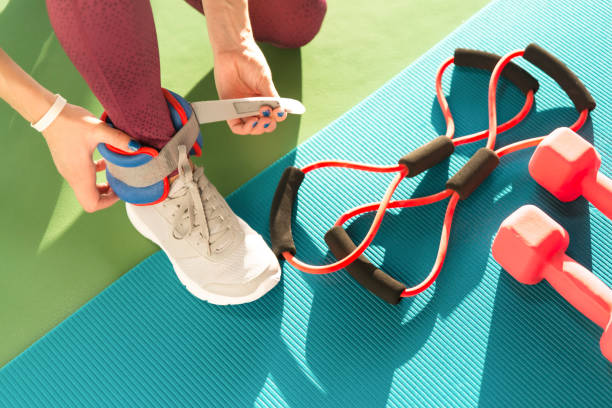Remember the ’80s fitness trend of ankle weights? Well, they’re back and better than ever. Ankle weights have made a comeback in the fitness world and are now being added into various workout routines. If you’re wondering how to use ankle weights and whether they actually work, this article has the answers you’re looking for.
Boost Your Workout with Ankle Weights
The primary advantage of ankle weights is that they add resistance to your training. By strapping these weights to your ankles, you activate your muscles in a different way and make them work harder, leading to increased strength and stamina, according to Lauren Leavell, a NASM-certified personal trainer and corrective exercise specialist.
Ankle weights offer versatility, similar to wrist weights. They are portable and can be taken anywhere, making them ideal for travelers or those without access to a gym. You can adjust ankle weights to your desired workout level, whether you’re seated, in tabletop position, or standing, as Leavell suggests.
Additionally, ankle weights can target and isolate specific muscle groups. They are particularly useful for strengthening weak muscles due to inactivity or postural issues. For example, if you spend most of your day at a desk, you may develop weak glutes.
Ankle weights can be beneficial in physical therapy settings for addressing lower-body ailments, such as weak hamstrings or knee issues, notes Holly Perkins, C.S.C.S., author of Lift to Get Lean.
Apart from muscle activation, ankle weights can also help increase bone density. Stronger bones are essential for preventing osteoporosis, a condition more prevalent in women. Resistance exercises, like using ankle weights, improve bone mass density and reduce the risk of fractures, explains Emilie Goldblum, an intuitive stretch movement body coach and former Olympic rhythmic gymnast.
Even something as simple as walking with ankle weights can contribute to maintaining bone density, according to Michele Olson, Ph.D., an exercise physiologist and senior clinical professor.
Free Your Movement with Ankle Weights
Ankle weights offer a level of freedom that traditional dumbbells and weights cannot match. They allow you to perform a wide range of movements in different directions and rotations, making them particularly valuable for hip work. The hip joint is known for its multidirectional mobility, and strengthening the various muscles involved can enhance overall stability and performance, explains Perkins.
Using Ankle Weights Safely and Effectively
Before incorporating ankle weights into your routine, it’s crucial to feel confident in your form for each exercise you plan to perform. Start without any additional resistance, ensuring that you’re comfortable with the exercises before adding ankle weights. Pay attention to maintaining proper form throughout your movements, avoiding overarched backs and engaging your core.
To use ankle weights effectively, choose the appropriate weight load for each exercise. When walking with ankle weights, keep them light, ideally three to five pounds maximum. Using heavier weights while walking can alter your stride and place undue stress on your lower back and pelvis, warns Olson. For specific exercises like donkey kicks, you can use five- to 10-pound weights on each leg. However, it’s essential to find the weight load that challenges you in the last two reps of each set, according to Perkins.
Before starting any new fitness routine, consult with your doctor or a medical expert to ensure it is suitable for you. This is especially important if you have any pre-existing conditions or concerns.
To gradually incorporate ankle weights into your routine, start with low-impact exercises. Begin with a 20-minute walk while wearing one-pound ankle weights. This allows your body to adjust to the added resistance gradually. As you become more comfortable, you can increase the duration and intensity of your workouts.
Low-impact workout modalities, such as barre and Pilates, are particularly well-suited for ankle weights. These exercises focus on controlled movements, and adding ankle weights can take your practice to the next level, says Leavell. As you progress, you can incorporate ankle weights a few times a week into your low-impact exercises.
To help you get started, here are effective ankle weight exercises you can try when you work out at Club Fitness.
Standing Leg Extension
- Stand with your feet hip-width apart, balancing on your right foot.
- Bend your left leg at a 90-degree angle, with toes pointed.
- Extend your left leg behind you, feeling a gentle stretch in your hip flexor.
- Squeeze your hamstring and glute at full extension.
- Avoid overarching your lower back or lifting your left leg higher than is comfortable.
- Bend your left knee and return to the starting position.
- Engage your core to lift your knee.
- Repeat on both legs.
Standing Abductors
- Stand with your feet hip-width apart, hands on hips, and toes pointing forward.
- Bend your right knee to bring your right foot in line with your left ankle or left knee.
- Extend your right leg straight out to the right side, squeezing and lifting with your outer leg and glutes.
- Lower your right leg with control and return to the starting position with your right knee bent.
- For a modification, lightly touch the ball of your right foot to the ground between reps.
- Repeat on both legs.
Three-Legged Dog to Single-Leg Plank
- Begin in a downward dog position, starting on all fours in a tabletop position.
- Lift your hips up and back, straightening your legs to move into a downward dog.
- On an inhale, extend your left leg back up toward the ceiling, shifting your shoulders back and squeezing your glutes.
- On an exhale, pull your torso and shoulders forward into a high plank position, supporting your weight on your right leg only.
- Keep your shoulders stacked over your wrists and your hips square to the ground.
- Engage your core and imagine pushing the floor away to maintain proper form.
- For a modification, lightly touch your left foot to the ground between reps.
- Repeat on both legs.
Learn more here:
